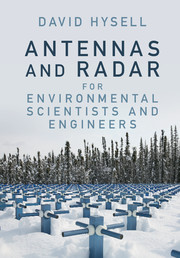Book contents
- Frontmatter
- Contents
- Preface
- 1 Introduction
- 2 Introduction to Antenna Theory
- 3 Antenna Arrays
- 4 Aperture Antennas
- 5 Noise
- 6 Scattering
- 7 Signal Processing
- 8 Pulse Compression
- 9 Propagation
- 10 Overspread Targets
- 11 Weather Radar
- 12 Radar Imaging
- Appendix A Radio Frequency Designations
- Appendix B Review of Electromagnetics
- References
- Index
- References
11 - Weather Radar
Published online by Cambridge University Press: 09 February 2018
- Frontmatter
- Contents
- Preface
- 1 Introduction
- 2 Introduction to Antenna Theory
- 3 Antenna Arrays
- 4 Aperture Antennas
- 5 Noise
- 6 Scattering
- 7 Signal Processing
- 8 Pulse Compression
- 9 Propagation
- 10 Overspread Targets
- 11 Weather Radar
- 12 Radar Imaging
- Appendix A Radio Frequency Designations
- Appendix B Review of Electromagnetics
- References
- Index
- References
Summary
Meteorological phenomena were vividly apparent to radar operators during the Second World War, and while the main concern lay in mitigating the effects of the radar clutter the weather produced, monitoring and forecasting the weather were also recognized as being important to the war effort. Precipitation was first observed by radar operators in Britain in 1940 and at the MIT Radiation Laboratory in 1941, and the first publication on meteorological echoes appeared in 1943. Also in 1943, Project Stormy Weather in Canada began, fostering an era of pioneering work in precipitation and cloud physics. Academic symposia and textbooks appeared immediately after the conclusion of the war. The availability of surplus radars spurred rapid development in the emerging science of radar meteorology. In the 1950s, operational networks of weather radar began to proliferate. Radar networks expanded throughout the succeeding decades, culminating in the United States with the deployment of the NEXRAD network of WSR-88D Doppler weather radars in the 1990s and the Terminal Doppler Warning Radar (TDWR) network, completed in 2011.
The principles of radar covered throughout this text apply directly to the study of weather. As in any subdiscipline, however, weather radar is accompanied by its own vernacular and specialized formalisms which have evolved historically to address the most pressing problems in the field. This chapter presents an overview of those problems and the attendant language and formalism.
When precipitation is present, backscatter from water or ice droplets or hydrometeors dominates all other forms of backscatter. Backscatter from hydrometeors is governed by the principles of Lorenz–Mie theory as outlined in Chapter 6. It is usually desirable to observe precipitation at wavelengths approximately an order of magnitude larger than the diameter of the precipitation drop size of interest. This maximizes scattering efficiency while preserving the applicability of Rayleigh scattering theory, simplifying the interpretation of the observations greatly. Table 11.1 lists representative drop sizes for different hydrometeor types. The NEXRAD radars operate at S-band frequencies between 2.7 and 3 GHz or wavelengths close to 10 cm. This is a good choice for observing most hydrometeors associated with severe weather. For observing clouds or clear air, C- and X-band radars are more commonly used. These radars present a much smaller physical footprint and can operate at lower power levels.
- Type
- Chapter
- Information
- Antennas and Radar for Environmental Scientists and Engineers , pp. 288 - 322Publisher: Cambridge University PressPrint publication year: 2018



